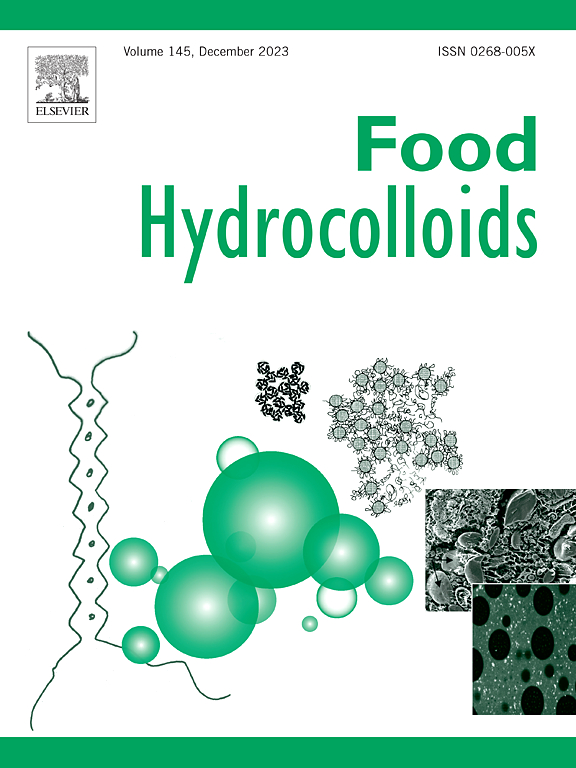Design of edible whey protein isolate hydrogels with cell adhesion via a two-step crosslinking method for cultured meat scaffolds
IF 11
1区 农林科学
Q1 CHEMISTRY, APPLIED
引用次数: 0
Abstract
Cultured meat is a promising solution to address the global food crisis, with the design of edible scaffolds being a key challenge in its production. Traditionally, materials containing RGD cell adhesion sites, such as gelatin, have been considered necessary to satisfy the need for cultured meat scaffolds with high cell adhesion. However, in this study, we propose a different view in which the biopolymer without inherent cell adhesion sites can also be used as the raw material to prepare edible hydrogel scaffolds for the production of cultured meat, eliminating the need for gelatin or unsafe chemical modifications. We developed edible hydrogel scaffolds from whey protein isolate (WPI) using a two-step crosslinking method to adjust their physical and structural properties, thereby imparting cell adhesive properties. Compared with the single-crosslinked WPI hydrogel, the obtained double-crosslinked WPI hydrogels exhibited higher Young's modulus (∼12.44–25.87 kPa), higher wettability (contact angle <40°), and positively shifted zeta potential, as well as denser gel networks and better hydration properties. These optimized hydrogels supported the adhesion, rapid proliferation, and successful differentiation of mouse skeletal C2C12 myoblasts and porcine muscle stem cells (PMuSCs), with the MTLC hydrogel (crosslinked using 80 U/g TGase and 2 % CaCl2) showing the best performance. Furthermore, textural analysis revealed that the products we produced were similar to fresh pork in texture. These findings highlight the potential of biopolymers without inherent adhesion sites as viable materials for the development of edible and functional scaffolds in cultured meat production.

用两步交联法设计具有细胞粘附性的可食用乳清分离蛋白水凝胶
人造肉是解决全球粮食危机的一个有希望的解决方案,可食用支架的设计是其生产中的一个关键挑战。传统上,含有RGD细胞粘附位点的材料,如明胶,被认为是满足具有高细胞粘附性的培养肉支架的必要材料。然而,在本研究中,我们提出了一种不同的观点,即没有固有细胞粘附位点的生物聚合物也可以用作制备用于生产培养肉的可食用水凝胶支架的原料,而无需明胶或不安全的化学修饰。以分离乳清蛋白(WPI)为原料,采用两步交联法制备可食用水凝胶支架,调整其物理和结构特性,从而提高细胞粘附性能。与单交联WPI水凝胶相比,得到的双交联WPI水凝胶具有更高的杨氏模量(~ 12.44 ~ 25.87 kPa)、更高的润湿性(接触角<;40°)和正位移的zeta电位,以及更致密的凝胶网络和更好的水化性能。这些优化的水凝胶支持小鼠骨骼C2C12成肌细胞和猪肌肉干细胞(PMuSCs)的粘附、快速增殖和成功分化,其中MTLC水凝胶(用80 U/g TGase和2% CaCl2交联)表现出最好的性能。此外,质地分析表明,我们生产的产品在质地上与新鲜猪肉相似。这些发现强调了没有固有粘附位点的生物聚合物作为可食用和功能性支架在培养肉生产中发展的可行材料的潜力。
本文章由计算机程序翻译,如有差异,请以英文原文为准。
求助全文
约1分钟内获得全文
求助全文
来源期刊

Food Hydrocolloids
工程技术-食品科技
CiteScore
19.90
自引率
14.00%
发文量
871
审稿时长
37 days
期刊介绍:
Food Hydrocolloids publishes original and innovative research focused on the characterization, functional properties, and applications of hydrocolloid materials used in food products. These hydrocolloids, defined as polysaccharides and proteins of commercial importance, are added to control aspects such as texture, stability, rheology, and sensory properties. The research's primary emphasis should be on the hydrocolloids themselves, with thorough descriptions of their source, nature, and physicochemical characteristics. Manuscripts are expected to clearly outline specific aims and objectives, include a fundamental discussion of research findings at the molecular level, and address the significance of the results. Studies on hydrocolloids in complex formulations should concentrate on their overall properties and mechanisms of action, while simple formulation development studies may not be considered for publication.
The main areas of interest are:
-Chemical and physicochemical characterisation
Thermal properties including glass transitions and conformational changes-
Rheological properties including viscosity, viscoelastic properties and gelation behaviour-
The influence on organoleptic properties-
Interfacial properties including stabilisation of dispersions, emulsions and foams-
Film forming properties with application to edible films and active packaging-
Encapsulation and controlled release of active compounds-
The influence on health including their role as dietary fibre-
Manipulation of hydrocolloid structure and functionality through chemical, biochemical and physical processes-
New hydrocolloids and hydrocolloid sources of commercial potential.
The Journal also publishes Review articles that provide an overview of the latest developments in topics of specific interest to researchers in this field of activity.
 求助内容:
求助内容: 应助结果提醒方式:
应助结果提醒方式:


